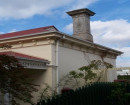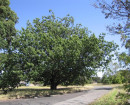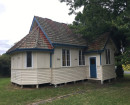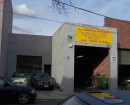STONEMASONS YARD
11 PIPER STREET KYNETON, MACEDON RANGES SHIRE
-
Add to tour
You must log in to do that.
-
Share
-
Shortlist place
You must log in to do that.
- Download report



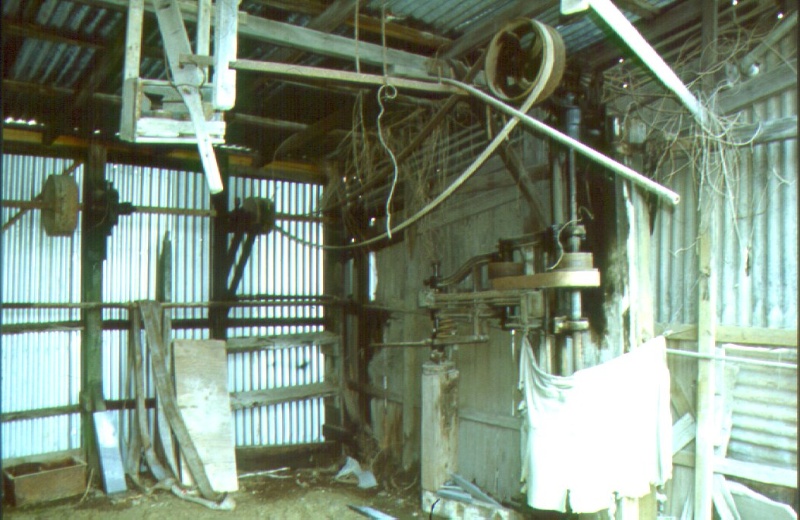
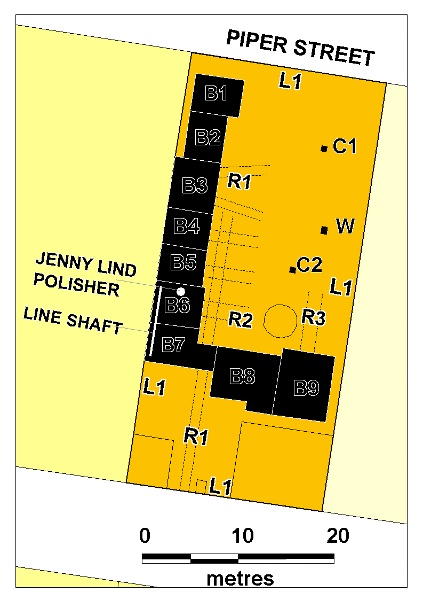
Statement of Significance
What is significant?
The Stonemasons Yard is situated in Piper Street within the township of Kyneton. Kyneton and the surrounding district has a rich array of stone buildings and stone rail infrastructure. The WT Jones stonemasons yard was originally established in Malmsbury and a second yard was established in Kyneton in the 1890's. During this time there was an abundance of loose bluestone and numerous small quarries established in the district, some of which supplied the masons yard with the local stone. An advertisement for the business dates back to 1898 and states: 'WT Jones Monumental and General Mason, Piper Street Kyneton and Mollison Street, Malmsbury'. The yard is currently operating under the same name of WT Jones and Sons Memorials.
The building layout consists of an L-shaped configuration of office buildings, engraving area, sandblasting, bush hammer area, polishers shed, sawing and drilling area, early gang saw shed and engine room. The operations are mainly outdoors, or under the cover of open sheds which all face a central open yard. The Jenny Lind Polisher which dates 1893 from Scotland is still in use. A network of trolley lines throughout the site indicate the working layout of the yard. The gang saw shed retains an A-frame timber structure that was used to support two gang saws which no longer remain on site. Gang saw blades, rails for the gang saw trolley and related winch, and a deposit of steel shot waste all give further indication of the importance of gang saw operation in earlier phases of operations on the site.
The two cranes, known as 'Stiff Legged Dykes' were manufactured in Melbourne and are used for lifting and moving larger stones. The larger crane dates from c1897, marked HW Mould Clyde Forge, South Melbourne. The smaller crane was purchased in 1942 from W Ferris, Monumental Mason who was located in Fitzroy and is marked Drysdale & Fraser Melbourne. Both of these cranes are visually prominent on the site and have been located to facilitate movement of heavy materials on and off and transport between the processing areas. The processing areas within the sheds are set out to follow a linear sequence of stone preparation from raw material to finished monumental product. The L-shaped configuration of buildings facilitates movement of the stones by the cranes. Office buildings are closest to the street and most of the stone is stored in the open yard central to the L-shaped building layout.
How is it significant?
The Stonemasons Yard, Kyneton is historically and technologically significant to the State of Victoria.
Why is it significant?
The Stonemasons Yard, Kyneton is historically significant as a representative example of a working monumental mason's yard. This yard exhibits many of the features of a typical working monumental masons operation where the basic processes have changed little since the late 19th century. It demonstrates a continuation of local stone working methods and practices since its inception in the 1890's.
The Stonemasons Yard, is of technological (scientific) significance as it demonstrates the typical processes of monumental stone working and the changing technologies instrumental in these processes. The site layout is clearly determined by the monumental masons work processes. Early technologies included the use of cranes and rail trolleys for the transport and movement of stone, the use of line shafting to drive the Jenny Lind polishing machine. The gradual adoption of new technologies is demonstrated by the removal of the gang saws and by the more recent use of diamond sawing and drilling machines.
-
-
STONEMASONS YARD - Permit Exemptions
General Exemptions:General exemptions apply to all places and objects included in the Victorian Heritage Register (VHR). General exemptions have been designed to allow everyday activities, maintenance and changes to your property, which don’t harm its cultural heritage significance, to proceed without the need to obtain approvals under the Heritage Act 2017.Places of worship: In some circumstances, you can alter a place of worship to accommodate religious practices without a permit, but you must notify the Executive Director of Heritage Victoria before you start the works or activities at least 20 business days before the works or activities are to commence.Subdivision/consolidation: Permit exemptions exist for some subdivisions and consolidations. If the subdivision or consolidation is in accordance with a planning permit granted under Part 4 of the Planning and Environment Act 1987 and the application for the planning permit was referred to the Executive Director of Heritage Victoria as a determining referral authority, a permit is not required.Specific exemptions may also apply to your registered place or object. If applicable, these are listed below. Specific exemptions are tailored to the conservation and management needs of an individual registered place or object and set out works and activities that are exempt from the requirements of a permit. Specific exemptions prevail if they conflict with general exemptions. Find out more about heritage permit exemptions here.Specific Exemptions:General Conditions: 1. All exempted alterations are to be planned and carried out in a manner which prevents damage to the fabric of the registered place or object. General Conditions: 2. Should it become apparent during further inspection or the carrying out of alterations that original or previously hidden or inaccessible details of the place or object are revealed which relate to the significance of the place or object, then the exemption covering such alteration shall cease and the Executive Director shall be notified as soon as possible. General Conditions: 3. If there is a conservation policy and plan approved by the Executive Director, all works shall be in accordance with it. General Conditions: 4. Nothing in this declaration prevents the Executive Director from amending or rescinding all or any of the permit exemptions. Nothing in this declaration exempts owners or their agents from the responsibility to seek relevant planning or building permits from the responsible authority where applicable.Buildings
* Repairs and maintenance which replace like with like
* Repainting of previously painted surfaces
* Replacement and installation of electrical, plumbing and pneumatic services.
* Interior fitouts to B1 and B2.
Cranes
* Replacement of crane timber components in original dimension and length.
* Repair of winding mechanism parts
* Replacement of metal crane parts with parts from cranes of same type and age.
* Minor modifications and additions to the cranes to improve safety of operation.
Rails
* Replacement of trolley rails in the same sections and gauge, excepting old gang saw rails.
STONEMASONS YARD - Permit Exemption Policy
The aspects of this place which are important to its significance include its continuous and continuing use, the whole of the functional layout and related fixed structures and movable objects. The trolley rails and sections of the cranes have been replaced in the past and are exposed to weathering and wear. In order to enable the ongoing use of the site exemptions are given for their repair and replacement of worn or decayed components.
The buildings are not architectural significance but are significant for their relationship to the functioning of the place and because their type of construction and use of material is appropriate to the historic character of the enterprise. The L-shaped layout of the buildings relating to the progression of working stone from basic cutting to fine polishing and lettering, the positioning of the cranes to facilitate movement between stations in this process, the open working spaces and visibility of the working yard from the street are all important factors which should be retained. The area at the rear of the complex is available for new structures of a similar scale to that of the original fabric.
As in the past, all works and processes of the stonemason’s yard should be allowed to continue.
In the interest of promoting ongoing use, consideration will be given allowing modification to structures and equipment which brings them up to current safety standards.
-
-
-
-
-
KYNETON COURT HOUSE
 Victorian Heritage Register H1472
Victorian Heritage Register H1472 -
FORMER BANK OF NSW AND RESIDENCE
 Victorian Heritage Register H0308
Victorian Heritage Register H0308 -
KYNETON DISTRICT HOSPITAL
 Victorian Heritage Register H1684
Victorian Heritage Register H1684
-
"1890"
 Yarra City
Yarra City -
'BRAESIDE'
 Boroondara City
Boroondara City -
'ELAINE'
 Boroondara City
Boroondara City
-
-







